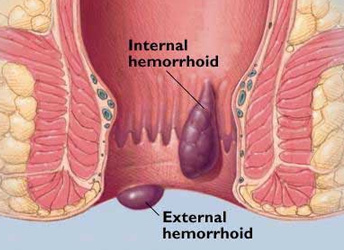Diseases | Children's Care | Piles / Haemorriods / Fissure in Ano

Piles (Haemorrhoids) are swollen and inflamed blood vessels (veins) in rectum and anus. Piles are broadly classified as follows,
External: Piles that are outside anal verge
Internal: Piles that occur inside the rectum
Causes of Piles: These include the following,
1) Genetic predisposition (weak rectal veins, walls)
2) Poor muscle tone in the rectal region
3) Constipation
4) Obesity
5) Sedentary lifestyle
6) Chronic cough
7) Pregnancy
8) Overuse of laxatives or enemas
9) Lifting heavy weights habitually
Some of the other symptoms generally associated with piles
1) Protrusion of piles outside the anus; this usually occurs after defecation, prolonged standing or unusual physical exertion
2) Bleeding from the anus: This can occur before, during or after stools. This will be bright red blood, not usually mixed with the stools, but often seen on the toilet paper.
3) Soreness, pain, itching in the anal region
4) In case of profuse bleeding that is chronic, the patient may be anemic
5) Sensation of something coming down, or a bulge or lump at the anus
6) If the piles outside the anus develop a blood clot inside, (thrombosed piles) it leads to a particularly tender, hard lump.
Symptoms of Piles:
Symptoms vary depending upon the site of piles, duration of complaints and general health of the person. External piles present as a swelling outside the anus with irritation and itching. These can be painful sometimes and usually do not bleed. Internal piles are usually not painful but these bleed when they are irritated such as during the passage of hard stools. They can be classified into four grades:
Grade 1 piles are small swellings on the inside lining of the anus. They cannot be seen or felt from outside the anus.
Grade 2 piles are partly pushed out (prolapse) from the anus when you go to the toilet, but quickly ‘retract back’ inside again.
Grade 3 piles hang out (prolapse) from the anus and are felt as one or more small, soft lumps that hang from the anus. However, they can be pushed back inside the anus with a finger.
Grade 4 piles permanently hang down from within the anus, and cannot be pushed back inside. They can sometimes become quite large.
Homeopathic Remedies for Piles:
The most commonly used homeopathic remedies for piles (Hemorrhoids) include:
Aloes: Sore pain in the anal area & pain in the pelvic region can be controlled with this remedy. Burning sensation in the rectum while passing stools can be controlled effectively with this remedy.
Muriatic Acid: Treatment In extreme cases of Piles where the person cannot bear touch, here muriatic acid is used to get relief. It is used in case of large, swollen, purple or blue hemorrhoids.
Sulphur: It is one of the useful remedies for controlling major symptoms of internal and external Piles. Itching, burning, pain in the anal area can be controlled with this medicine.
Arsenic Album: For patients who experience burning sensation while walking or standing, or those with swollen, bluish piles with lot of bleeding are treated with this remedy.
Aesculus Hippocastanum: This homeopathic medicine works better for patients with pain in back due to Hemorrhoids.
Calcarea fluorica: Internal piles with itching and bleeding in the anal area are treated with this medicine.
Graphites: This remedy works well for cases with cracks, soreness and itching around the anal area.
Hamamelis: This remedy works well for cases with cracks, soreness and itching around the anal area.
Nux vomica: Patient with painful itching and constipation can be treated with this remedy.
Fissure-in-ano (anal fissures) finds an excellent treatment with homeopathy. Most cases heal with medicines and surgery can be avoided. Most patients show significant improvement in about three to four weeks, in case of fissure-in-ano. The full length of treatment is usually for about four months. Some patients may need longer course of medication. It is possible to avoid surgery in most cases, if timely homeopathic treatment is used.
Tips to prevent piles:
1) Increase intake of fluids (Juices & Water)
2) High fiber diet
3) Exercise regularly
4) Sit in warm water tub for minimum 10 minutes
5) Eat more fresh fruits and vegetables
6) Avoid processed foods
7) Control your weight
8) Avoid too much of alcohol
9) Quit smoking
